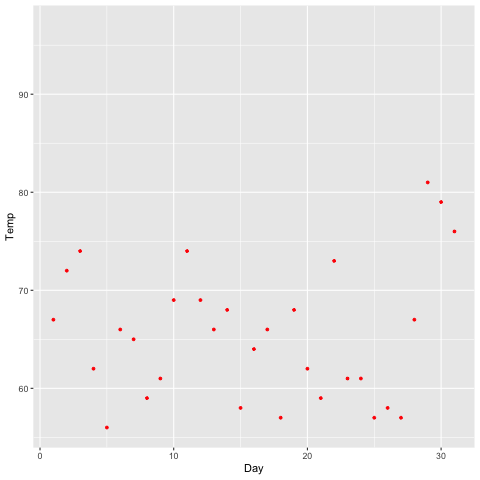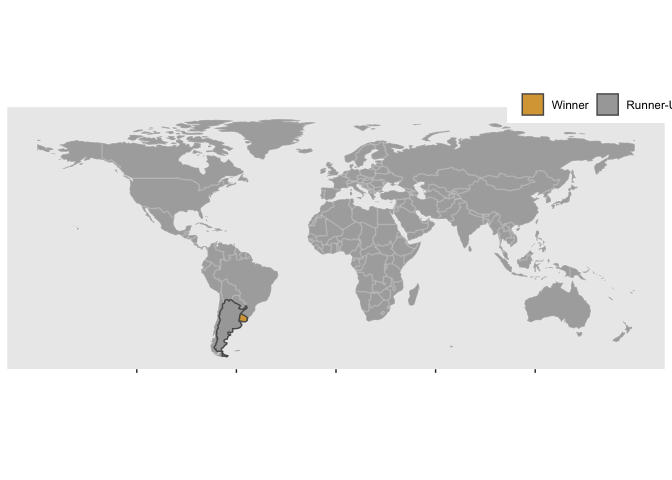Display different time elements at different speeds in gganimate
This is my rudimentary try by making a helper column which can be used as our transition_time to show how we can have different time step but desired labels.
You can later spend some more time to make a better *timestep columns which is more sophisticated and precisely meets your needs.
The main idea/point here is that we can use functions on the frame_time to get the labels as needed while the transition_time can be manipulated.
library(ggplot2)
library(gganimate)
library(dplyr)
g <- airquality %>%
group_by(Month) %>%
mutate(timestep = if_else(Month==5, ((1:n())-1)/2 + Month, 15 + Month)) %>%
ggplot(aes(Day, Temp, group = interaction(Month, Day))) +
geom_point(color = 'red', size = 1) +
transition_time(timestep) +
shadow_mark(colour = 'black', size = 0.75) +
enter_fade() +
labs(title = 'Month: {if_else(frame_time<21,5, ceiling(frame_time-15))}')
animate(g, nframes = 100)

Created on 2019-06-02 by the reprex package (v0.3.0)
How to make dots in gganimate appear and not transition
The transitions are ultimately tied to each data point's group. In your code, all the Day 1 data points are sharing a group, and so they appear from the old ones.
Give the points their own group (e.g. by using group = interaction(Month, Day)) and it should work.
a <- ggplot(airquality, aes(Day, Temp,
group = interaction(Month, Day))) +
geom_point(color = 'red', size = 1) +
transition_time(Month) +
shadow_mark(colour = 'black', size = 0.75) +
enter_fade() # I liked the look of this, but fine to leave out
animate(a, nframes = 100)

gganimate::transition_time results in flying polygons
This is a grouping issue. You need to be explicit with your groups. In this case, create an interaction of Year and w_l
You can use the package rnaturalearth to get world / country maps more conveniently.
library(tidyverse)
library(gganimate)
world <- rnaturalearth::ne_countries( returnclass = 'sf') %>% filter(admin!= 'Antarctica')
url <- "https://www.blog.cultureofinsight.com/data/wc.xlsx"
httr::GET(url, httr::write_disk("wc.xlsx", overwrite=TRUE))
winners <- readxl::read_excel("wc.xlsx") %>%
gather(w_l, country, winner:runner_up) %>%
mutate(w_l = factor(w_l, levels = c("winner", "runner_up")))
wc_geo <- left_join(world, winners, by = c("admin" = "country")) %>%
drop_na(Year)
p <-
ggplot() +
geom_sf(data = world, colour = "#ffffff20", fill = "#2d2d2d60", size = .5) +
geom_sf(data = wc_geo, aes(fill = w_l, group = interaction(w_l, Year))) +
scale_fill_manual(values = c("#D9A441", "#A8A8A8"), name = NULL, labels = c("Winner", "Runner-Up")) +
theme(legend.position = c(0.9, 1.01), legend.direction = "horizontal", axis.text = element_blank(),
panel.grid.minor = element_blank(), panel.grid.major = element_blank())
anim <- p + transition_time(Year)
animate(anim)

Created on 2020-04-24 by the reprex package (v0.3.0)
P.S. It's always the same countries, isn't it...
latest gganimate: How to have a fixed plot in the background?
This has already been addressed in an issue for gganimate on GitHub: https://github.com/thomasp85/gganimate/issues/94
Basically you specify the the layers that are meant to be static with a separate data frame from the one you initially passed to ggplot. The example in the GitHub ticket I referred to is
library(gganimate)
#> Loading required package: ggplot2
ggplot(dat = data.frame(x=1:10,y=1:10), aes(x=x,y=y)) +
geom_point() +
geom_line(data = data.frame(x2 = 1:10, y = 1:10),
aes(x = x2, y = y, group = 1)) +
transition_time(x)
animate(last_plot(), nframes = 50)
Here the line is held static, while the point is moving.
How to use multiple cores to make gganimate faster
This is a pull request, meaning that the code is available on GitHub as a branch, but hasn't yet been merged in gganimate master.
You could clone it or copy the modified package directory on your system.
Then :
- make sure that
devtoolspackage is installed - open
gganimate.Rproj - run
devtools::load_all(".")
The parallel version is ready to run :
anim <- ggplot(mtcars, aes(mpg, disp)) +
transition_states(gear, transition_length = 2, state_length = 1) +
enter_fade() +
exit_fade()
future::plan("sequential") ## default
t0 <- system.time(animate(anim))
print(t0)
# user system total
# 4.384615 1.360656 1.893855
future::plan("multiprocess", workers = 4L)
t1 <- system.time(animate(anim))
# user system total
# 1.30 0.61 3.58
print(t0 / t1)
# user system total
# 4.384615 1.360656 1.893855
To avoid load_all you could open the DESCRIPTION file and rename the package :
Package: gganimateparallel
Type: Package
Title: A Grammar of Animated Graphics
...
As vignettes seem to have difficulties to build, you can just remove the vignettes directory.
Then RStudio / Build / Install and restart or from the package's directory
Rcmd.exe INSTALL --no-multiarch --with-keep.source .
gganimateparallel is now available on your system as a library.
Credits @HenrikBengtsson for the incredible job done on future!
Related Topics
How Can One Mix 2 or More Color Palettes to Show a Combined Color Value
Character "|" in Strsplit Function (Vertical Bar/Pipe)
Downgrade R Version (No Issues with Bioconductor Installation)
Get Rows of Unique Values by Group
Highlight a Single "Bar" in Ggplot
Align Points and Error Bars in Ggplot When Using 'Jitterdodge'
Terms of a Sum in a R Expression
Creating a Prng Engine for <Random> in C++11 That Matches Prng Results in R
Converting Multiple Boolean Columns to Single Factor Column
Control Padding of Grobs Added to Patchwork
Modify Spacing Between Key Glyphs in Vertical Legend Whilst Keeping Key Glyph Border
How to Subset Column Variables in Df1 Based on the Important Variables I Got in Df2
Add Multiple Curves/Functions to One Ggplot Through Looping
How to Decode Postgresql Bytea Column Hex to Int16/Uint16 in R
Aggregating Monthly Column Values into Quarterly Values
Preventing Incosistent Spacing/Bar Widths in Geom_Bar with Many Bars